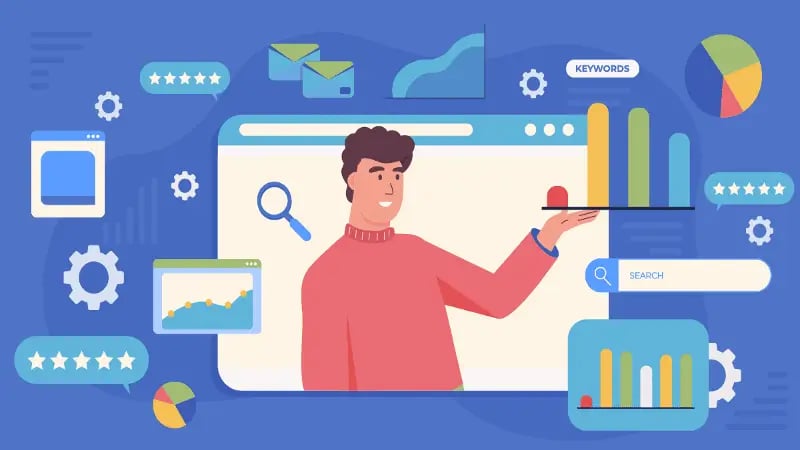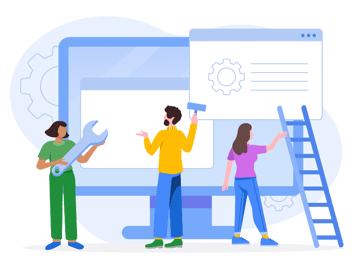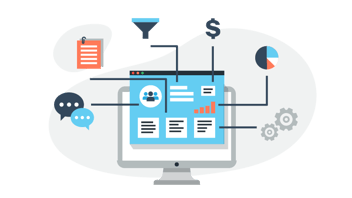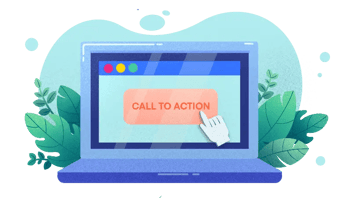What is Conversion Rate Optimization and Why Does It Matter?
You've poured your heart and soul into crafting a beautiful, informative website and invested in SEO to attract a steady stream of visitors. But a harsh reality hits—a whopping 97% of those visitors leave without making a purchase, signing up for your email list, or taking any other desired action. That's a lot of potential customers slipping through the cracks!
This is where conversion rate optimization (CRO) comes in. It's not magic, but it might feel like it. CRO is the strategic process of fine-tuning your website to transform website visitors into paying customers or engaged leads. Think of it like perfecting your online storefront—making it clear, easy to navigate, and irresistible to your target audience.
By implementing CRO strategies, you can unlock a treasure trove of benefits for your business.
-
Boosting your sales: Converting even a small percentage of those lost visitors into customers can have a significant impact on your bottom line.
-
Squeezing more juice from your marketing budget: CRO helps you maximize the return on investment (ROI) from your existing marketing efforts by converting more website traffic you've already attracted.
-
Lowering customer acquisition costs: Acquiring new customers can be expensive. CRO helps you leverage your existing website traffic, reducing the need for constant, expensive marketing campaigns.
In short, CRO is the bridge between attracting visitors and turning them into loyal customers. It's the secret weapon that can propel your business growth and leave you wondering why you didn't implement it sooner.
What is Conversion Rate Optimization?
Conversion rate optimization (CRO) is the systematic process of increasing the percentage of website visitors who take a desired action (conversion) on a website. This action can vary depending on business goals, including purchases, email signups, free trial downloads, demo requests, quote requests, or any other valuable interaction.
CRO utilizes a combination of user research, web analytics tools, A/B testing, and website optimization techniques to identify areas for improvement and implement changes that lead to a statistically significant increase in conversion rates. The goal of CRO is to maximize the return on investment (ROI) from website traffic by transforming passive visitors into engaged users and, ultimately, loyal customers.
What are Conversions?
Before diving into CRO strategies, let's understand what a "conversion" truly means. It's not just about someone buying something. Conversions encompass the desired actions you want visitors to take on your website, and these can vary depending on your business goals. Here are some common types of conversions:
-
Purchases: The holy grail for e-commerce websites, converting visitors into paying customers.
-
Email Signups: Building your email list allows for ongoing marketing and nurturing leads.
-
Free Trial Downloads or Demo Requests: Enticing potential customers to experience your product or service firsthand.
-
Quote Requests or Contact Form Submissions: Generating leads for your sales team to follow up with.
-
Event Registrations or Webinar Signups: Increasing engagement with your brand and thought leadership.
The key to successful CRO lies in knowing what specific actions you want visitors to take on each page. A generic "contact us" form on your homepage might not be as effective as a targeted "schedule a demo" button on your product page. Identify clear conversion goals for different campaigns and web pages to optimize the user journey.
The Conversion Funnel
Imagine a funnel – wide at the top, narrowing at the bottom. That's essentially the conversion funnel, representing the customer journey. Here's a breakdown of the key stages:
-
Awareness: Visitors become aware of your brand or product, often through marketing efforts.
-
Consideration: Visitors are intrigued and want to learn more about your offering. They're considering you against competitors and evaluating the value proposition.
-
Decision: Visitors have weighed their options and are ready to make a choice. This stage focuses on finalizing the decision and taking action.
CRO helps you optimize each stage of the conversion funnel. By ensuring a clear value proposition, intuitive navigation, and engaging content at the top (Awareness), you capture attention and pique visitor interest. Addressing concerns with trust signals and social proof in the Consideration stage helps them understand why your product or service is the best choice. Finally, optimizing the checkout process minimizes friction and encourages them to take action in the Decision stage.
Why Conversions Fail
Unfortunately, website visitors don't always seamlessly glide through the conversion funnel. Here are some common reasons why they might abandon ship:
-
Unclear Value Proposition: Visitors don't understand what makes your product or service unique and valuable to them.
-
Confusing Website Navigation: A labyrinthine website makes it difficult for visitors to find what they're looking for, leading to frustration and abandonment.
-
Lengthy Forms: Nobody enjoys filling out endless forms. Streamlining forms with only essential fields can significantly improve conversions.
-
Lack of Trust Signals: Without clear social proof, testimonials, or security assurances, visitors might hesitate to convert.
-
Complicated Checkout Process: A lengthy or confusing checkout process is a major conversion killer. Aim for a smooth, one-click checkout experience if possible.
Statistics paint a clear picture: 47% of online shoppers abandon carts due to a complicated checkout process. By addressing these roadblocks with CRO strategies, you can ensure a smooth and frictionless journey for your website visitors, leading to more conversions and a thriving business.
Conversion Rate Optimization Strategies
Before diving headfirst into website tweaks, successful CRO requires an understanding of how visitors actually interact with your site. This is where user research and web analytics tools become your secret weapons.
User Research and Analytics
User Research
Techniques like user testing and surveys can provide invaluable insights into user behavior, pain points, and preferences. Watching real people navigate your website can reveal unexpected roadblocks and areas for improvement.
Web Analytics Tools
Powerhouses like Google Analytics and HubSpot paint a data-driven picture of user behavior. By analyzing key metrics, you can identify areas for optimization:
-
Heatmaps: These visual representations show where users click, scroll, and spend their time on your website. Hotspots indicate areas of high engagement, while cold spots reveal sections that might be confusing or uninteresting.
-
Click-Through Rates (CTRs): This metric measures the percentage of visitors who click on a specific element, like a call-to-action button or a product link. Low CTRs suggest the element might need a redesign or clearer messaging.
-
Bounce Rates: The percentage of visitors who leave your website after viewing only one page indicates a potential problem. High bounce rates might signify a lack of relevance on the landing page or confusing navigation.
-
Time on Site: The average amount of time visitors spend on your website provides a general sense of user engagement. Low time on site could indicate the content is irrelevant or the navigation is cumbersome.
By analyzing these data points and user research findings, you can pinpoint areas that need improvement and prioritize your CRO efforts strategically.
A/B Testing
Imagine having a magic crystal ball that shows you which website elements convert better. Well, A/B testing is the closest thing we have! It's a powerful technique that allows you to compare two different versions of a website element (like a headline, call-to-action button, or landing page layout) and see which one performs better in terms of conversions. Companies that A/B test their websites see an average revenue increase of 39%.
Here's how it works: You create two variations (version A and version B) of the element and randomly show each version to a portion of your website traffic. After a statistically significant amount of data is collected, you can analyze which version resulted in more conversions.
Here are some practical examples of A/B testing:
-
Headline Showdown: You have two different headlines for your product page. One is generic and descriptive, while the other is more benefit-oriented and attention-grabbing. Use A/B testing to see which headline captures visitor interest and leads to more clicks on the "buy now" button.
-
CTA Clash: Are you using a simple "Learn More" button or a more action-oriented "Download Your Free Trial" button? A/B testing can reveal which call to action entices visitors to take the next step.
-
Landing Page Layout Lab: You're unsure whether a single-column layout or a two-column layout with product images would be more effective on your product landing page. A/B testing helps you choose the winner that drives more conversions.
CRO Best Practices
Now that you have the user data and A/B testing tools, let's explore specific CRO techniques you can implement:
-
Compelling Calls to Action (CTAs): Don't settle for bland "Submit" buttons. Craft clear and concise CTAs with strong verbs that communicate the benefit of taking action. For example, "Download Your Free Trial Today!" is more enticing than "Get Started."
-
Mobile-Friendly Design: In today's mobile-first world, a responsive website design is crucial. Ensure your website displays flawlessly and offers a seamless user experience across all devices (phones, tablets, desktops). Remember, 73% of mobile users say they'd be more likely to buy from a business with a mobile-friendly website.
-
High-Quality Product Images and Videos: Visuals are powerful persuasion tools. Showcase your products or services with high-resolution images and captivating videos that highlight their value and functionality.
-
Customer Testimonials and Social Proof: Social proof builds trust and credibility. Feature positive customer testimonials, case studies, and client logos to demonstrate the value your offerings bring to real people.
-
Clear and Concise Website Copy: Speak directly to your target audience's needs and pain points. Use clear, concise language that's easy to understand and avoids jargon.
-
Streamlined Checkout Process: Make the checkout process as quick and painless as possible. Minimize the number of steps, offer guest checkout options, and ensure a secure payment gateway.
-
Live Chat or Chatbot Functionality: Provide real-time support through live chat or a chatbot to answer visitor questions, address concerns, and guide them through the conversion funnel. This can significantly improve user experience and conversion rates.
Don't expect to implement a few tweaks and magically see conversions skyrocket. CRO is an ongoing process of experimentation, analysis, and refinement. Continuously monitor your data, identify areas for improvement, and test new strategies to keep your website optimized for maximum conversions.
There are also a number of helpful CRO tools and resources available to make your journey smoother. These might include heat mapping tools for visualizing user behavior, A/B testing platforms for running controlled experiments, and conversion rate optimization blogs and communities for staying up-to-date on the latest CRO trends.
The impact of successful conversion rate optimization can be truly transformative. Imagine increasing your online sales by 15% or doubling your email signups. These are just a few examples of the dramatic results CRO can deliver. By implementing these strategies and fostering a culture of continuous improvement, you can turn your website into a conversion powerhouse, driving business growth and achieving long-term success.
br>Unlock Your Website's Conversion Potential
Let's face it, attracting website visitors is only half the battle. Conversion rate optimization bridges the gap, transforming those website visitors into loyal customers and driving real business results.
Remember, CRO helps you:
-
Boost Sales and Revenue: Every additional conversion translates to more money in your pocket.
-
Maximize Marketing ROI: Get the most out of your existing marketing efforts by converting more website traffic.
-
Reduce Customer Acquisition Costs: Focus on nurturing existing website visitors instead of constantly chasing new leads.
Ready to unlock the power of CRO? Partner with Aspiration Marketing! Our team of seasoned professionals who can help you develop and implement a data-driven CRO strategy tailored to your specific business goals.
Don't let website visitors slip through the cracks. Embrace the power of CRO, turn website traffic into loyal customers, and watch your business thrive in the digital age.
This content is also available in:
- German: Was ist Conversion Rate Optimierung und warum ist sie wichtig?
- Spanish: Optimización de la tasa de conversión y por qué es importante
- French: C'est quoi l'optimisation du taux de conversion? Est-elle importante?
- Italian: L'ottimizzazione del tasso di conversione e perché è importante
- Romanian: Ce este optimizarea ratei de conversie și de ce este importantă?
- Chinese: 什么是转换率优化,为什么它很重要?










Leave a Comment